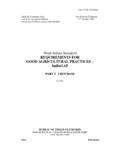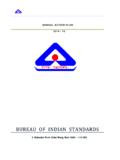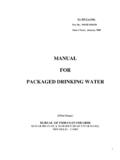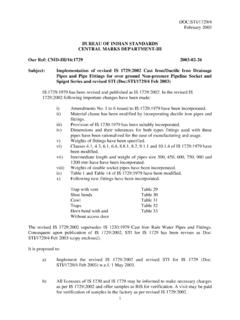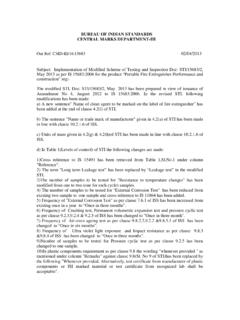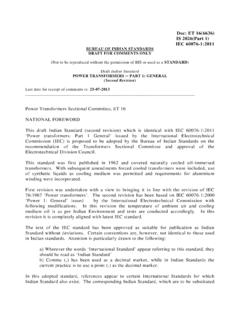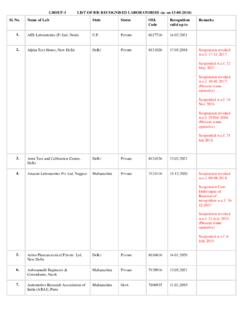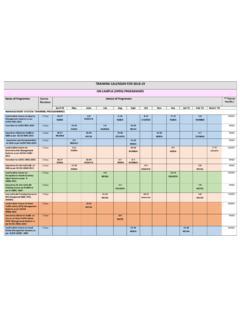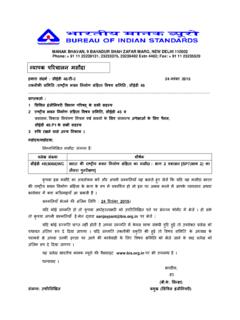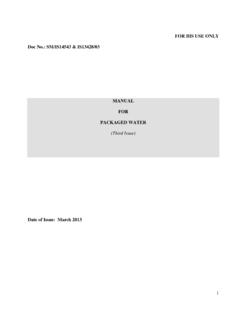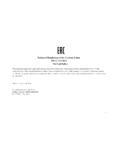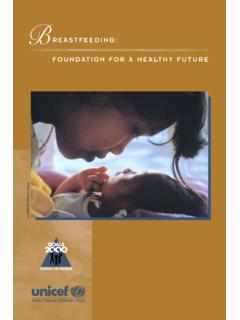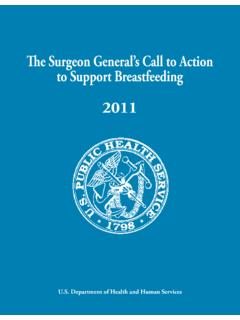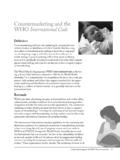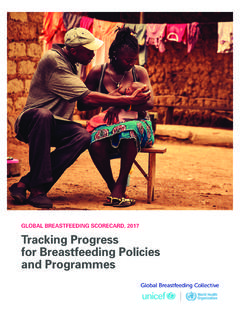Transcription of DRAFT IN WIDE CIRCULATION DOCUMENT DESPATCH …
1 DRAFT IN WIDE CIRCULATION . DOCUMENT DESPATCH ADVICE. REF: DATE: PCD 21( 2662)C 07-03-2013. TECHNICAL COMMITTEE: Plastic containers Sectional Committee, PCD 21. To i) All interested members of PCDC. ii) All members of Plastic Containers Sectional Committee, PCD 21. iii) All others interested. Dear Sir, Please find enclosed the following DOCUMENT : Doc: No. Title Doc:PCD 21(2662)C Plastic feeding Bottle (First Revision). Kindly examine this DRAFT and forward your views stating any difficulty which you are likely to experience in your business or profession, if this is finally adopted as an Indian Standard.
2 Last date for comments is : 15 June 2013. Comments if any, may please be made in the format as given overleaf and mailed to the undersigned at the above address. The DOCUMENT is also hosted on BIS website Thanking you, Dr. (Mrs.) Vijay Malik Sc. F' & Head (PCD). Office Telephone/Fax No.: 011 23235432. Encl.: As above. E-mail: FORMAT FOR SENDING COMMENTS ON BIS DOCUMENTS. (Please use A4 size sheet of paper only and type within fields indicated. Comments on each clauses/sub-clauses/table/fig. etc be started on a fresh box. Information in Column 4 should include reasons for the comments and suggestions for modified wording of the clauses when the existing text is found not acceptable.)
3 Adherence to this format facilitates Secretariat's work). Doc. No: PCD21(2662). TITLE: Plastic feeding bottle (First Revision). LAST DATE OF COMMENTS: 15 JUNE 2013. NAME OF THE COMMENTATOR/ORGANIZATION: _____. Sl. Clause/Sub- Commentator/ Type of Comments Justification Proposed No. clause/ Organization/ (General/Editorial/ change para/table/fig. Abbreviation Technical). No. commented .. 21/ -2662C 07 03 2013. 21.. , 21 . , ( ) .. / , : .. 1. 21 (2662) . ( 14625 . ).. : .. : 15 2013. - . , .. ( ) . ( ). : For Comments Only Doc:PCD 21( 2662)C. March 2013. BUREAU OF INDIAN standards .
4 DRAFT Indian Standard PLASTICS FEEDING BOTTLES. (First Revision of IS 14625). ICS No. ; Last date for comments 15 June 2013. FOREWORD. (formal clause will be added later). Feeding bottles are universally used in feeding infants. An Indian Standard on 'Glass Feeding Bottles' was published as IS 5168: 1969. Over the last few decades plastics have become indispensable and have taken over glass, metal and paper as a material of choice in many sectors. In view of the convenience in usage plastics have become an automatic choice in the manufacturing of feeding bottles. Section 11(2) of infant Milk Substitutes, Feeding Bottle and infant Foods (Regulation of Production, Supply and Distribution) Act, 1992 states that 'No person shall sell or otherwise distribute any feeding bottle unless it conforms to the Standard Mark specified by the Bureau of Indian standards referred to in sub-section (1) for feeding bottles and such mark is affixed on its container'.
5 The Act has been subsequently amended as The infant Milk Substitute, Feeding Bottles and infant Foods (Regulation of Production, Supply and Distribution) Amendment Act, 2003. Section 2(c) of this Act defines the feeding bottles(see ). These considerations led the committee to formulate a specification for plastics feeding bottles in 1999. This standard covered polycarbonate (PC), polypropylene (PP) and polyethersulfone (PES) as raw material for manufacturing plastics feeding bottles owing to their excellent transparency and sterlizability. Recently through studies, serious concerns have been raised about the polycarbonate type of plastic bottles because they contain Bisphenol A which has serious health concerns even in very low dosages.
6 It has been reported that BPA-containing plastic baby bottles leached high levels of Bisphenol A which is harmful for infants. Bisphenol A (BPA) having chemical formula (CH3)2C(C6H4OH)2 , (IUPAC name 4,4'- (propane-2,2-diyl)diphenol) is a building block monomer for polycarbonate resin that in turn are used to manufacture infant feeding bottles. It is used to make them clear and nearly shatter-proof. Accordingly BPA has been banned for use in manufacturing polycarbonate for infant feeding bottles by many countries including US, EU, Canada, Australia, Brazil, Malaysia, China etc.
7 In this (first) revision all modifications carried out through four amendments on previous version have been incorporated. Use of polycarbonate as a material for manufacturing infant feeding bottles have been deleted in view of reports on Bisphenol A and olefin based polymers as material for manufacture of feeding bottles have been included. While preparing this standard considerable assistance has been derived from the following publications: MS 735 : 2012 : 'Specification for plastic feeding bottles', issued by standards and Industrial Research Institute of Malaysia, Malaysia; and EN 14350-1 : 2004 Child use and care articles - Drinking equipment - Part 1: General and mechanical requirements and tests EN 14350-2 : 2004 Child use and care articles - Drinking equipment - Part 2: Chemical requirements and tests Code of Federal Regulations Title 21, Volume 3 CITE: as of April 1, 2012.
8 EEC Directives Commission Implementing Regulation (EU) No 321/2011 of 1 April 2011. amending Regulation (EU) No 10/2011 as regards the restriction of use of Bisphenol A in plastic infant feeding bottles JIS T 9112: 1997 'Feeding bottles', issued by Japanese standards Association, Japan;. General information regarding ECO Mark is given in Annex E to this standard. For the purpose of deciding whether a particular requirement of this standard is complied with, the final value, observed or calculated, expressing the result of a test or analysis, shall be rounded off in accordance with IS 2 : 1960 'Rules for rounding off numerical values (revised)'.
9 The number of significant places retained in the rounded off value should be the same as that of the specified value in this standard. DRAFT Indian Standard PLASTICS FEEDING BOTTLES. 1 SCOPE. This DRAFT standard prescribes the requirements and methods of sampling and test for infant plastic feeding bottles, receptacles and accessories excluding teats. 2 REFERENCES. The following standards contains provisions which through reference in this text constitute provisions of this standard. At the time of publication the editions indicated were valid. All standards are subject to revisions, and parties to agreements based on this standard are encouraged to investigate the possibility of applying the most recent editions of the standards indicated below: IS No.
10 Title 249: 1979 Sodium bichromate, technical (third revision). 266: 1993 Sulphuric acid (third revision). 1070: 1992 Distilled water(third revision). 1699 : 1995 Methods of Sampling and Test for Food Colours 2798: 1998 Methods of test for plastics containers (first revision). 3565 : 1966 Specification for rubber teats for feeding bottles [under revision as Doc: PCD 13( 2457)]. 4905: 1968 Methods for random sampling 7019: 1998 Glossary of terms in plastics and flexible packaging excluding paper (second revision). 8747: 1977 Methods of tests for environmental stress-crack resistance of blowmoulded polyethylene containers 9833: 1981 List of pigments and colourants for use in plastics in contact with foodstuffs, pharmaceuticals and drinking water [ DRAFT revision finalized for printing Doc : PCD12 ( 2592)].
